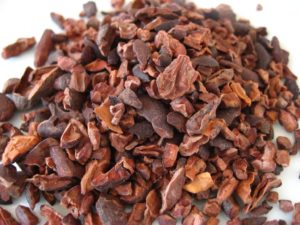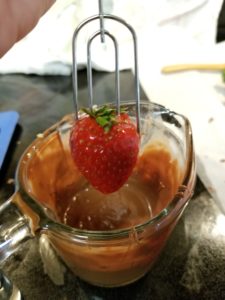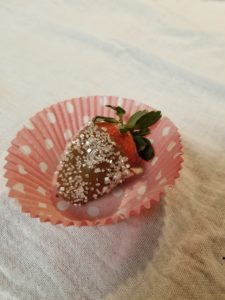
Chocolate, a candy oh so easy to eat, yet oh so tricky to make and use. You ask why is it so tricky to make and use? You can thank chemistry for that. In order to be able to properly work with chocolate, it is best to know the basics behind it. Let’s start at the beginning…
Chocolate as defined by Wikipedia is “a usually sweet, brown, food preparation of roasted and ground cacao seeds”. Based on that definition, chocolate is a food preparation which means it is a mixture of different ingredients. Basic chocolate is a mixture of cacao solids, cacao butter, some sort of sweetener such as sugar or condensed milk, sometimes milk, and sometimes a flavoring. Chocolate can be a liquid, solid or paste. We will talk more about the ingredients in chocolate a bit later. First, we need to understand how the cacao seed is made into the chocolate liquor used to make the chocolate we know and love.

 Cacao Tree and Cacao Nibs
Cacao Tree and Cacao Nibs
Cacao, also known as cocoa, comes from the Cacao Tree (Theobroma Cacao) which can be found in warm, tropical climates. The pod, also known as the bean, contains 30-45 seeds and it is the nibs of the seeds that is used to make chocolate. Today we aren’t going to focus on the process from bean to bar. We are more interested in the bar form of chocolate that we can manipulate into tasty treats, but just for your curiosity here are the basic steps:
- Growing
- Harvesting
- Removing Cacao
- Fermenting
- Drying
- Roasting and Winnowing
- Grinding
- Conching
- Tempering and Molding
If you would like a more detailed explanation of all these steps, Equal Exchange is a great site that explains this process.
It is the grinding step where chocolate starts to come into shape. During grinding the nibs are ground into chocolate liquor (aka cocoa mass or cocoa solids), which is a paste and has no alcoholic content despite the name. Chocolate liquor can either be used directly in the production of chocolate bars or further processed to separate the fat, known as cocoa butter from the solids. The solids left after the fat is separated out is called the cocoa presscake. Cocoa butter can be used in the making of chocolate bars or beauty products, where the presscake can be milled into cocoa powder used in baking cocoa or hot chocolate.
 Grinding
Grinding
Conching is basically the blending of the chocolate liquor, cocoa butter, and other ingredients to make chocolate bars. It also takes out some of the acidity from the cacao. This process can take up to 24 to 72 hours. The longer you blend the finer your particles in your end product will be. Some commercial companies use soy lecithin, an emulsifier, which speeds up the blending process to save time and money. Natural chocolate does not contain the emulsifier.
 Conching
Conching
After all the ingredients are blended, the chocolate is tempered and molded. Tempering is alternating cooling and warming of the chocolate while decreasing the temperature in order to create the perfect crystallization of the ingredients in chocolate. There are six known forms of chocolate crystals (polymorphs). Each polymorph produces different properties in the finished product. Polymorph V is considered perfect and is difficult to achieve. We will talk more about crystallization when we discuss the ingredients in chocolate.
Polymorph table and their properties
| Polymorph | Melting Temperature | Properties |
| I | 64.4°F | Soft, crumbly, melts easily, noticeable blooming |
| II | 69.8°F | Soft, crumbly, melts easily, noticeable blooming |
| III | 78.8°F | Firm, average snap, melts easily, some blooming |
| IV | 82.4°F | Firm, average snap, melts easily, some blooming |
| V | 93.2°F | Glossy, smooth texture, firm, melts in mouth |
| VI | 96.8°F | Hard, slow melt, some blooming |
After tempering is complete, additional ingredients such as nuts or sea salt is added. The chocolate is then poured into molds, cooled and wrapped.
 Tempered chocolate being molded
Tempered chocolate being molded
Now that we know how chocolate is made, we can talk about the ingredients that go into chocolate. As we discussed above, chocolate is made with chocolate liquor, cocoa butter, sugar, milk, and vanilla. Typical chocolate is 10 to 20% cacao, 8 to 16% milk solids, 32 to 60% sugar, 10 to 20% cocoa butter, and 1.2% Theobromine and Polyphenols. These ingredients contain many natural chemicals and compounds. Let’s talk about a few.
Cocoa Solids

Cocoa solids are the non-fat component of the cocoa bean after the cocoa butter is extracted from the chocolate liquor. The nutrients in the cocoa bean are found the greatest in cocoa solids over cocoa butter. Cocoa solids contain several minerals including calcium, copper, magnesium, phosphorus, potassium, sodium, and zinc. The solids also contain large amounts of caffeine and theobromine. Cocoa solids also contain clovamide and are rich in flavonoids.
Theobromine
Theobromine is an alkaloid belonging to plants. It can be found in tea, coffee, kola nut, and chocolate, though chocolate is the richest source. Theobromine is similar to caffeine and has many of the same stimulant effects on the human brain. This is the reason you feel good when you eat chocolate.
Anandamide
Anandamide is an endogenous cannabinoid that is produced naturally in the brain, but can be found in small amounts in chocolate. It helps to stimulate the brain and open synapses, which allows the feel good waves to transmit more readily. This effects the same structures of the brain as THC, though you would need to eat tons of chocolate to feel the same effects.
Phenylethylamine (PEA)
Phenylethylamine is a chemical that stimulates the brain’s pleasure center and is released when we fall in love. Chocolate has the highest amounts of PEA contained in any food. Most PEA in chocolate is metabolized before it hits the central nervous system, making it unlikely to have any aphrodisiac effects on the brain.
Flavonoids
Cocoa solids are rich in flavonoids. A flavonoid is a plant metabolite and is mostly in the pigmentation of the plant. Flavonoids have antioxidant properties that reduce cellular and arterial damage and even ageing. Flavonoids are usually bitter, so the amount in the chocolate depends on how much processing the cocoa solids undergo. Chocolate bars have a few flavonoids where as the cocoa bean has a lot.
Cocoa Butter

 Fat bloom
Fat bloom
Cocoa butter, also known as Theobroma oil, is an edible vegetable fat that is extracted from the cocoa bean. Cocoa butter is the fat solid of chocolate liquor. The cocoa nibs contain 54 to 58% cocoa butter. Cocoa butter only contains trace amounts of theobromine and caffeine. Cocoa butter is a fat that is made up of three fatty acids that are linked by an ester bond to glycerol. The three fatty acid molecules are Palmitic acid, Stearic acid, and Oleic acid. During the tempering process, it is the cocoa butter that creates the six different chocolate crystal structures. The different crystal structures are different ratios of the three fatty acid molecules.
When we were discussing chocolate polymorphs, we mentioned blooming as a property. Blooming is when a white or grey coating forms on the chocolate. It looks unpleasant and has a rough texture, but completely safe to eat. You can also temper the chocolate again which recombines the fat and sugars to get rid of the bloom. Fat bloom is related to cocoa butter. Fat bloom occurs when the cocoa butter in the chocolate coagulates into large globules, resulting in a greasy, grey coating. Causes of fat bloom include poor storage (too warm), incorrect tempering or cooling during production, mixing incompatible fats with cocoa butter during production.
Sugar
Sugar is largest ingredient in chocolate. It is used to offset the bitter taste of the cocoa. It can be in the granular form or condensed milk form. Sugar is a simple carbohydrate, that once consumed, quickly splits into glucose and fructose. Glucose provides a burst of energy while activating the reward center in the brain.
The second type of bloom that can occur with chocolate is sugar bloom. Sugar bloom occurs when moisture condenses on the chocolate. Sugars within the chocolate absorb the moisture and dissolve. When the excess moisture evaporates, the sugar reforms into larger crystals, resulting in a white, dusty, dry-feeling layer.
 Sugar bloom
Sugar bloom
You can now thank chemistry and chocolate makers the next time you bite into a delicious chocolate treat. Chemistry effects the taste, aroma, texture, and color of chocolate. Once you ingest chocolate, science keeps working to influence your brain and make you feel good. As a chocolatier, it is important to know this chemistry, so you can properly work with chocolate and make beautiful chocolate art and tasty treats.
So thank you chemistry and thank you mother nature for giving us the wonder that is chocolate.
I will leave you with this…
“Chocolate is one of the world’s most beloved discoveries, and when we need a quick boost of energy and endorphins, chocolate is the go-to treat”.
–Marcus Samuelsson

References
http://chocolate.mit.edu/science/
https://equalexchange.coop/products/chocolate/steps
https://www.science.org.au/curious/everything-else/chocolate
https://en.wikipedia.org/wiki/Chocolate#Bars
https://en.wikipedia.org/wiki/Cocoa_butter









